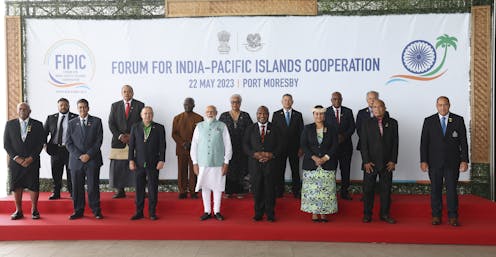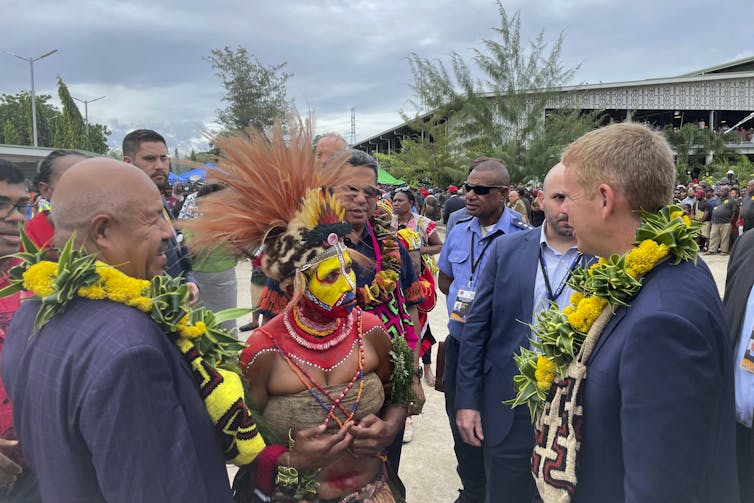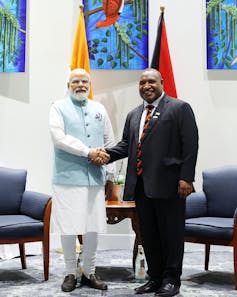Source: The Conversation (Au and NZ) – By Ian Kemish, Adjunct Professor, School of Historical and Philosophical Inquiry, The University of Queensland

AP/AAP
Papua New Guinea has been in the international spotlight over the past week, hosting a remarkable series of visits by foreign leaders and senior representatives.
Prime Minister Narendra Modi of India received an enthusiastic welcome on Monday when he arrived in Port Moresby for the first visit by an Indian head of government and to meet with 14 visiting leaders of the Pacific Island Forum countries and territories. PNG Prime Minister James Marape stooped to touch Modi’s feet on arrival, welcoming him as the “leader of the Global South”.
United States Secretary of State Antony Blinken also visited Port Moresby at the start of the week. Blinken was standing in for US President Joe Biden, whose much-anticipated stopover in the country was cancelled, along with his planned subsequent visit to Australia, because of the crisis in the US Congress over the federal debt ceiling.
Blinken signed two important agreements with PNG during his visit: a Defence Cooperation Agreement (DCA) and an Agreement Concerning Counter Illicit Transnational Maritime Activity Operations.
While in Port Moresby, Blinken also convened the latest in a series of high-level meetings between the US and Pacific leaders. New Zealand Prime Minister Chris Hipkens and Australian Senator Pat Conroy were also present.

Nick Perry/AP/AAP
These two visits were only part of a broader, substantial uptick in external engagement in PNG. In April, British Foreign Secretary James Cleverly visited the country, signing a defence framework agreement. It’s understood Indonesian President Joko Widodo will be there in June.
France has also recently signed a status of forces agreement with PNG. Meanwhile, Australia is negotiating a security treaty that is expected to substantially upgrade its longstanding defence cooperation agreement.
This activity all reflects the increasing importance of the Pacific Island countries in the strategic calculations of the democratic powers amid growing Chinese influence and heightened US-China tensions in the region. This is particularly true of PNG. It’s the largest nation in the region by far, located only a few kilometres from Australia, near the intersection point between Asia and the Pacific.
Amid all the colour and movement in Port Moresby this week, at least two important shifts were detectable in the dynamics of the region.
The Modi visit provided the clearest signal yet of India’s intention to join longstanding regional partners in demonstrating to the Pacific the value of prioritising engagement with the democratic world. With its inspirational development narrative, major power status and cultural links to the region, India could play an important role if it follows up with substantive collaboration with the region on climate change, security and sustainable development.
The updated defence arrangements between PNG and the United States, combined with the now-established pattern of senior US-Pacific political dialogue, recent growth in regional US development support and the upgrading of its regional diplomatic network, provide some corroboration that a long-promised American recommitment to the Pacific is finally under way.
Biden’s planned visit would have sealed this message symbolically – it would have been the first ever to a Pacific Island country. Its cancellation was undoubtedly a setback, but its impact should not be overstated given the practical displays of US commitment.
The text of the DCA will not be officially released until it is formally adopted into US law. However, the signatories have indicated that it updates an old status of forces agreement and aims to strengthen PNG Defence Force capabilities, including in humanitarian assistance and disaster response, and will allow for increased joint military training.
A draft leaked to the PNG media before the Blinken visit suggested the US might have substantial access to PNG facilities.
The maritime arrangement will allow the US Coast Guard to support surveillance in PNG’s exclusive economic zone and help combat illicit transnational activity through joint sea operations.
Students at several PNG universities protested against what they saw as a lack of transparency about the defence agreement. They expressed fears it compromised the country’s independence by bringing it more firmly into the US sphere of control. Some opposition political figures spoke of the risk of angering China and thus inviting potentially harmful repercussions for PNG’s economic security.
But Marape and his government stood their ground. Marape argued the agreement had “nothing to do with China” and PNG’s sovereignty remained intact. He also pointed to his government’s “healthy” relationship with Beijing and China’s status as an important trading partner for PNG. He has firmly rejected accusations that the arrangements for visiting US military personnel would violate PNG law.
PNG will nonetheless remain committed to its “friends to all, enemies to none” foreign policy approach. It will continue to leverage its growing array of relationships for its economic development.
In recent years, PNG’s leaders have joined others from the Pacific in expressing impatience with the strategic rivalry between their external partners and alarm at signs of greater militarisation in the region. India’s refusal to align itself firmly with one side or another in the geostrategic contest will be seen by many in the region as a model.
While Chinese investment and development support for PNG actually remains very limited compared to that of Australia, it looms large as a trading partner. Chinese state-owned enterprises are now heavily engaged in PNG, particularly its construction sector.

AP/AAP
It is also clear that Australia’s partners have come to understand they cannot leave it to Australia alone to carry the democratic standard in the Pacific. While Modi’s decision not to invite Australia and New Zealand to the formal component of the India-Pacific meeting (they were invited to a lunch) raised eyebrows, it may actually have been quite useful.
If the objective is for India to step forward into a substantive and positive regional role, then it probably helps that the symbolism of the India-Pacific meeting was not diluted by “traditional” partners detailing their own familiar cooperative efforts with the region.
If Australia wants others to share the load in the Pacific, it doesn’t follow that it always has to be involved. Australian government strategists likely think this has been a good week in PNG.
![]()
Ian Kemish is a former High Commissioner to PNG. He chairs the Kokoda Track Foundation and is the Pacific representative of the Global Partnership for Education, both of which receive funding from The Australian Government. He is affiliated with the ANU National Security College and the Griffith Asia Institute in addition to his adjunct position at the University of Queensland. He advises a range of companies on PNG and the Pacific.
– ref. World leaders are flocking to Papua New Guinea. Here’s why – https://theconversation.com/world-leaders-are-flocking-to-papua-new-guinea-heres-why-206091







